Understanding Aboriginal People in Sydney: Culture and Heritage
VerifiedAdded on 2020/05/28
|6
|1356
|119
Essay
AI Summary
This essay examines the Aboriginal people of Sydney, focusing on the Gadigal people and the Eora Nation, the original inhabitants of the Sydney district. It details their connection to the land, ancestral stories, and rituals, highlighting their resilience in the face of European settlement. The essay discusses the impact of colonization, the survival of the Gadigal culture, and the integration of Aboriginal communities into modern Sydney. It explores the political activism of Aboriginal people, their influence on the government, and the development of their education system. The essay references an upcoming exhibition, "The Aboriginals of Sydney: Our Heritage," and its potential to enhance understanding of Aboriginal culture and heritage. It also touches on the linguistic diversity of the region, including the Dharug, Dharawal, and Guringai languages, and the importance of fishing and marine occupations to the tribes. The essay concludes by emphasizing the significance of the exhibition in providing tools for a better understanding of the community and the cultural legacy of the Aboriginal people of Sydney.
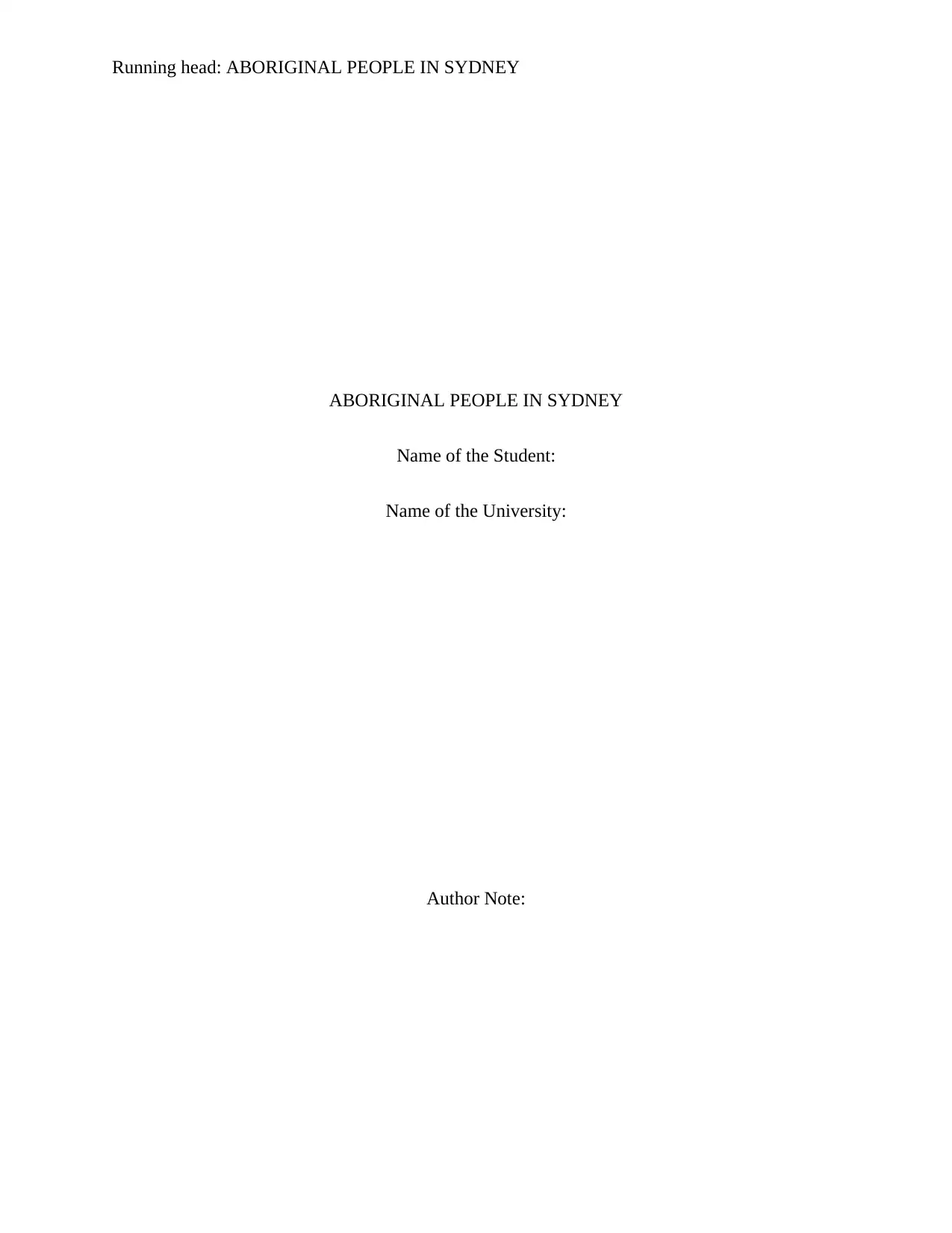
Running head: ABORIGINAL PEOPLE IN SYDNEY
ABORIGINAL PEOPLE IN SYDNEY
Name of the Student:
Name of the University:
Author Note:
ABORIGINAL PEOPLE IN SYDNEY
Name of the Student:
Name of the University:
Author Note:
Paraphrase This Document
Need a fresh take? Get an instant paraphrase of this document with our AI Paraphraser
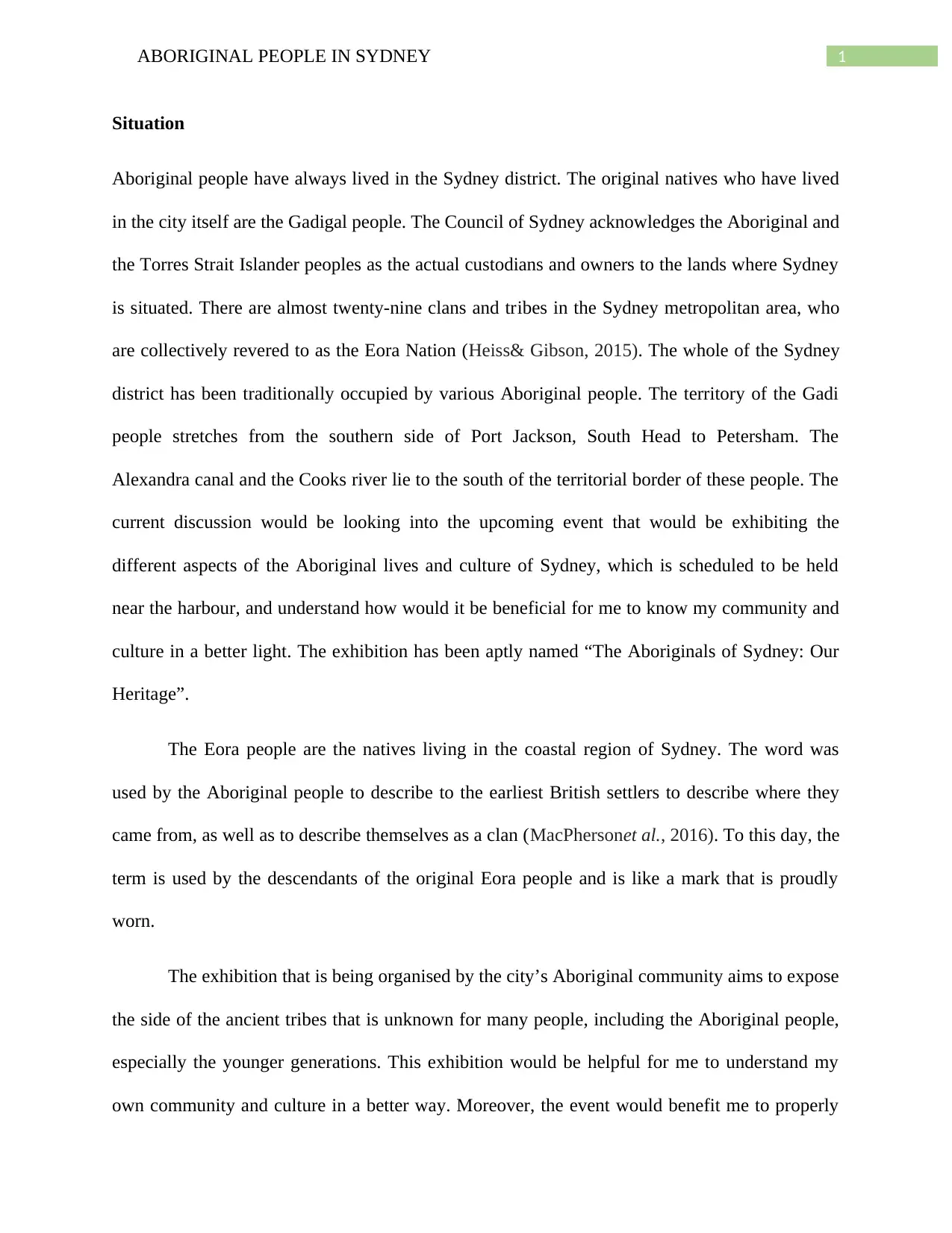
1ABORIGINAL PEOPLE IN SYDNEY
Situation
Aboriginal people have always lived in the Sydney district. The original natives who have lived
in the city itself are the Gadigal people. The Council of Sydney acknowledges the Aboriginal and
the Torres Strait Islander peoples as the actual custodians and owners to the lands where Sydney
is situated. There are almost twenty-nine clans and tribes in the Sydney metropolitan area, who
are collectively revered to as the Eora Nation (Heiss& Gibson, 2015). The whole of the Sydney
district has been traditionally occupied by various Aboriginal people. The territory of the Gadi
people stretches from the southern side of Port Jackson, South Head to Petersham. The
Alexandra canal and the Cooks river lie to the south of the territorial border of these people. The
current discussion would be looking into the upcoming event that would be exhibiting the
different aspects of the Aboriginal lives and culture of Sydney, which is scheduled to be held
near the harbour, and understand how would it be beneficial for me to know my community and
culture in a better light. The exhibition has been aptly named “The Aboriginals of Sydney: Our
Heritage”.
The Eora people are the natives living in the coastal region of Sydney. The word was
used by the Aboriginal people to describe to the earliest British settlers to describe where they
came from, as well as to describe themselves as a clan (MacPhersonet al., 2016). To this day, the
term is used by the descendants of the original Eora people and is like a mark that is proudly
worn.
The exhibition that is being organised by the city’s Aboriginal community aims to expose
the side of the ancient tribes that is unknown for many people, including the Aboriginal people,
especially the younger generations. This exhibition would be helpful for me to understand my
own community and culture in a better way. Moreover, the event would benefit me to properly
Situation
Aboriginal people have always lived in the Sydney district. The original natives who have lived
in the city itself are the Gadigal people. The Council of Sydney acknowledges the Aboriginal and
the Torres Strait Islander peoples as the actual custodians and owners to the lands where Sydney
is situated. There are almost twenty-nine clans and tribes in the Sydney metropolitan area, who
are collectively revered to as the Eora Nation (Heiss& Gibson, 2015). The whole of the Sydney
district has been traditionally occupied by various Aboriginal people. The territory of the Gadi
people stretches from the southern side of Port Jackson, South Head to Petersham. The
Alexandra canal and the Cooks river lie to the south of the territorial border of these people. The
current discussion would be looking into the upcoming event that would be exhibiting the
different aspects of the Aboriginal lives and culture of Sydney, which is scheduled to be held
near the harbour, and understand how would it be beneficial for me to know my community and
culture in a better light. The exhibition has been aptly named “The Aboriginals of Sydney: Our
Heritage”.
The Eora people are the natives living in the coastal region of Sydney. The word was
used by the Aboriginal people to describe to the earliest British settlers to describe where they
came from, as well as to describe themselves as a clan (MacPhersonet al., 2016). To this day, the
term is used by the descendants of the original Eora people and is like a mark that is proudly
worn.
The exhibition that is being organised by the city’s Aboriginal community aims to expose
the side of the ancient tribes that is unknown for many people, including the Aboriginal people,
especially the younger generations. This exhibition would be helpful for me to understand my
own community and culture in a better way. Moreover, the event would benefit me to properly
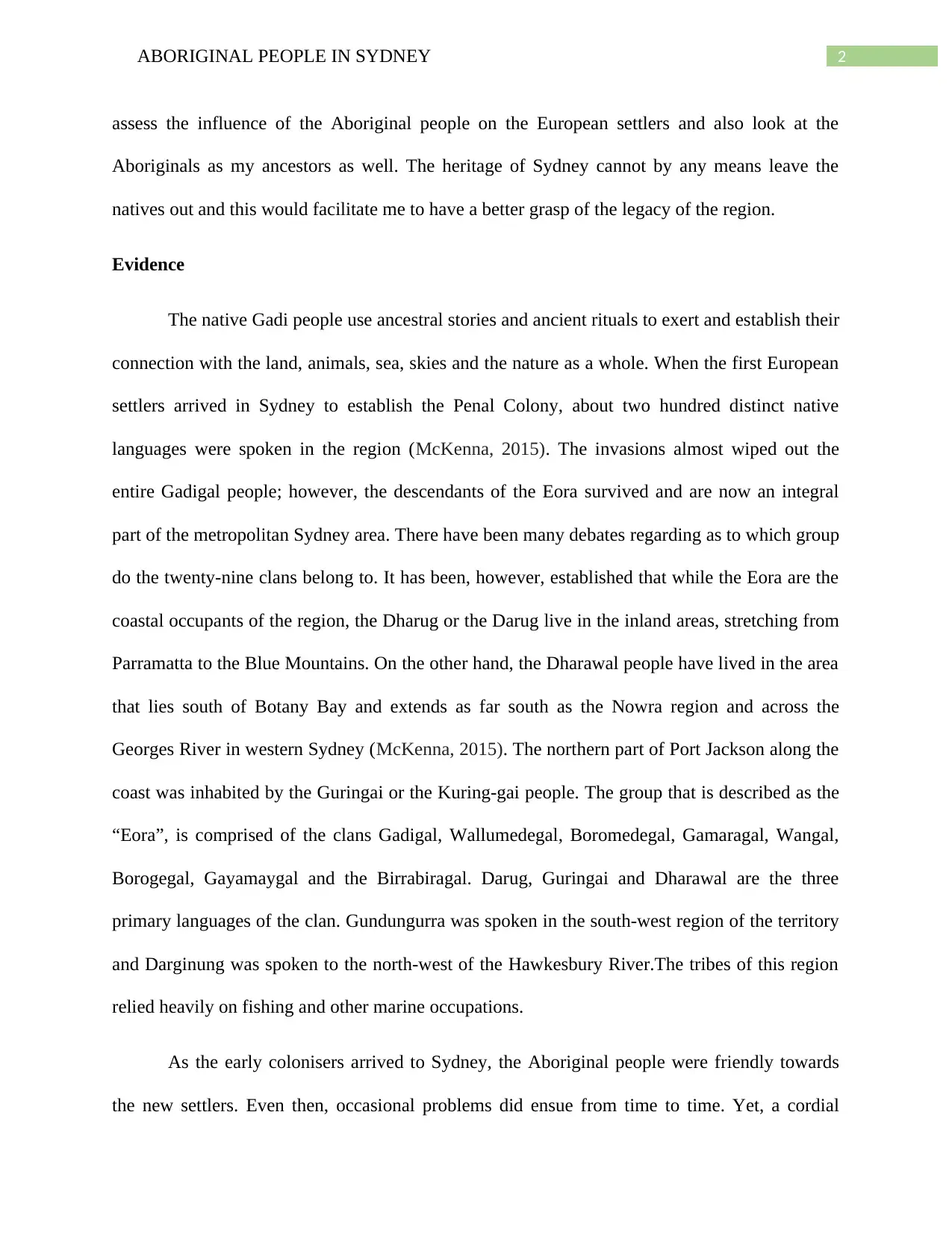
2ABORIGINAL PEOPLE IN SYDNEY
assess the influence of the Aboriginal people on the European settlers and also look at the
Aboriginals as my ancestors as well. The heritage of Sydney cannot by any means leave the
natives out and this would facilitate me to have a better grasp of the legacy of the region.
Evidence
The native Gadi people use ancestral stories and ancient rituals to exert and establish their
connection with the land, animals, sea, skies and the nature as a whole. When the first European
settlers arrived in Sydney to establish the Penal Colony, about two hundred distinct native
languages were spoken in the region (McKenna, 2015). The invasions almost wiped out the
entire Gadigal people; however, the descendants of the Eora survived and are now an integral
part of the metropolitan Sydney area. There have been many debates regarding as to which group
do the twenty-nine clans belong to. It has been, however, established that while the Eora are the
coastal occupants of the region, the Dharug or the Darug live in the inland areas, stretching from
Parramatta to the Blue Mountains. On the other hand, the Dharawal people have lived in the area
that lies south of Botany Bay and extends as far south as the Nowra region and across the
Georges River in western Sydney (McKenna, 2015). The northern part of Port Jackson along the
coast was inhabited by the Guringai or the Kuring-gai people. The group that is described as the
“Eora”, is comprised of the clans Gadigal, Wallumedegal, Boromedegal, Gamaragal, Wangal,
Borogegal, Gayamaygal and the Birrabiragal. Darug, Guringai and Dharawal are the three
primary languages of the clan. Gundungurra was spoken in the south-west region of the territory
and Darginung was spoken to the north-west of the Hawkesbury River.The tribes of this region
relied heavily on fishing and other marine occupations.
As the early colonisers arrived to Sydney, the Aboriginal people were friendly towards
the new settlers. Even then, occasional problems did ensue from time to time. Yet, a cordial
assess the influence of the Aboriginal people on the European settlers and also look at the
Aboriginals as my ancestors as well. The heritage of Sydney cannot by any means leave the
natives out and this would facilitate me to have a better grasp of the legacy of the region.
Evidence
The native Gadi people use ancestral stories and ancient rituals to exert and establish their
connection with the land, animals, sea, skies and the nature as a whole. When the first European
settlers arrived in Sydney to establish the Penal Colony, about two hundred distinct native
languages were spoken in the region (McKenna, 2015). The invasions almost wiped out the
entire Gadigal people; however, the descendants of the Eora survived and are now an integral
part of the metropolitan Sydney area. There have been many debates regarding as to which group
do the twenty-nine clans belong to. It has been, however, established that while the Eora are the
coastal occupants of the region, the Dharug or the Darug live in the inland areas, stretching from
Parramatta to the Blue Mountains. On the other hand, the Dharawal people have lived in the area
that lies south of Botany Bay and extends as far south as the Nowra region and across the
Georges River in western Sydney (McKenna, 2015). The northern part of Port Jackson along the
coast was inhabited by the Guringai or the Kuring-gai people. The group that is described as the
“Eora”, is comprised of the clans Gadigal, Wallumedegal, Boromedegal, Gamaragal, Wangal,
Borogegal, Gayamaygal and the Birrabiragal. Darug, Guringai and Dharawal are the three
primary languages of the clan. Gundungurra was spoken in the south-west region of the territory
and Darginung was spoken to the north-west of the Hawkesbury River.The tribes of this region
relied heavily on fishing and other marine occupations.
As the early colonisers arrived to Sydney, the Aboriginal people were friendly towards
the new settlers. Even then, occasional problems did ensue from time to time. Yet, a cordial
⊘ This is a preview!⊘
Do you want full access?
Subscribe today to unlock all pages.

Trusted by 1+ million students worldwide
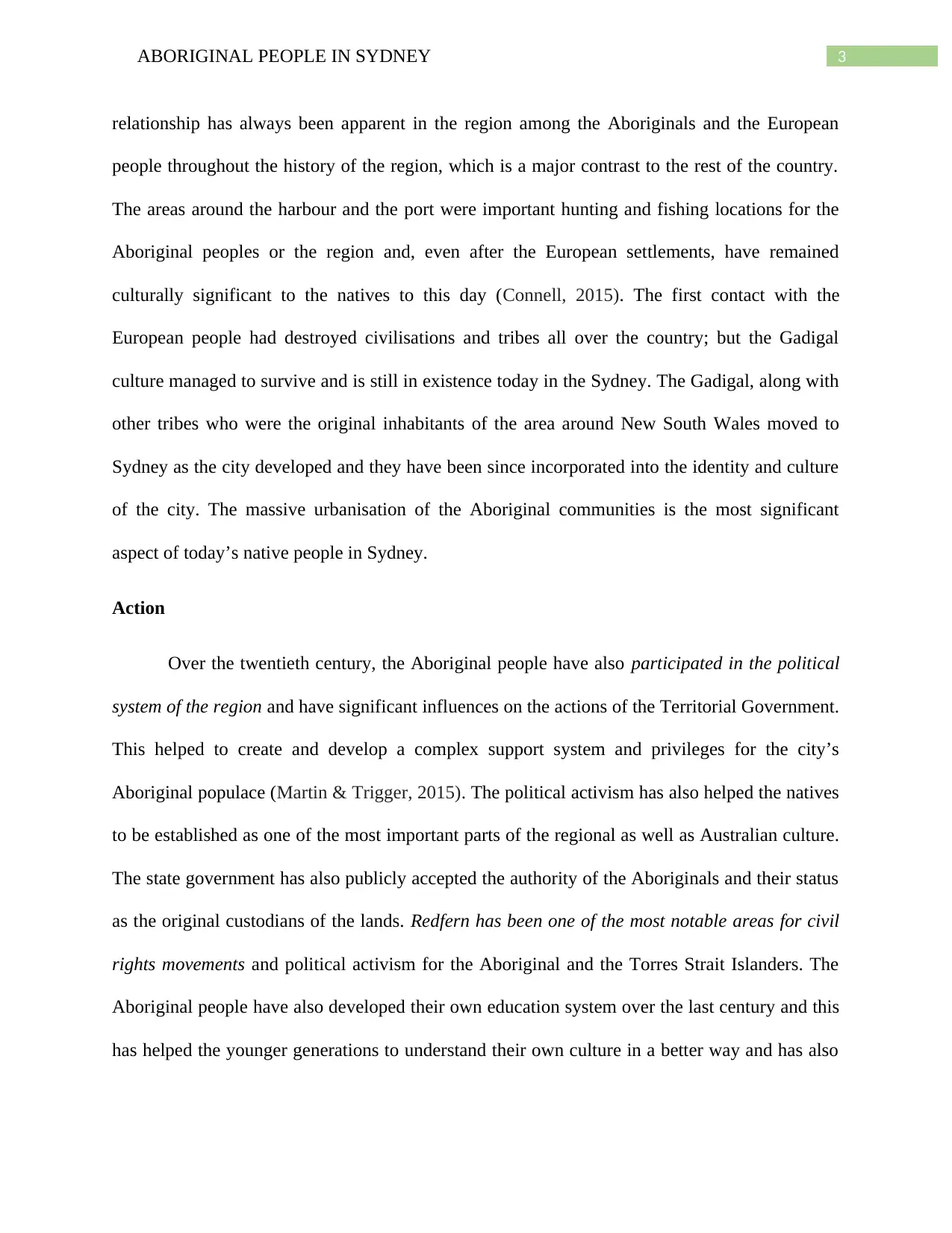
3ABORIGINAL PEOPLE IN SYDNEY
relationship has always been apparent in the region among the Aboriginals and the European
people throughout the history of the region, which is a major contrast to the rest of the country.
The areas around the harbour and the port were important hunting and fishing locations for the
Aboriginal peoples or the region and, even after the European settlements, have remained
culturally significant to the natives to this day (Connell, 2015). The first contact with the
European people had destroyed civilisations and tribes all over the country; but the Gadigal
culture managed to survive and is still in existence today in the Sydney. The Gadigal, along with
other tribes who were the original inhabitants of the area around New South Wales moved to
Sydney as the city developed and they have been since incorporated into the identity and culture
of the city. The massive urbanisation of the Aboriginal communities is the most significant
aspect of today’s native people in Sydney.
Action
Over the twentieth century, the Aboriginal people have also participated in the political
system of the region and have significant influences on the actions of the Territorial Government.
This helped to create and develop a complex support system and privileges for the city’s
Aboriginal populace (Martin & Trigger, 2015). The political activism has also helped the natives
to be established as one of the most important parts of the regional as well as Australian culture.
The state government has also publicly accepted the authority of the Aboriginals and their status
as the original custodians of the lands. Redfern has been one of the most notable areas for civil
rights movements and political activism for the Aboriginal and the Torres Strait Islanders. The
Aboriginal people have also developed their own education system over the last century and this
has helped the younger generations to understand their own culture in a better way and has also
relationship has always been apparent in the region among the Aboriginals and the European
people throughout the history of the region, which is a major contrast to the rest of the country.
The areas around the harbour and the port were important hunting and fishing locations for the
Aboriginal peoples or the region and, even after the European settlements, have remained
culturally significant to the natives to this day (Connell, 2015). The first contact with the
European people had destroyed civilisations and tribes all over the country; but the Gadigal
culture managed to survive and is still in existence today in the Sydney. The Gadigal, along with
other tribes who were the original inhabitants of the area around New South Wales moved to
Sydney as the city developed and they have been since incorporated into the identity and culture
of the city. The massive urbanisation of the Aboriginal communities is the most significant
aspect of today’s native people in Sydney.
Action
Over the twentieth century, the Aboriginal people have also participated in the political
system of the region and have significant influences on the actions of the Territorial Government.
This helped to create and develop a complex support system and privileges for the city’s
Aboriginal populace (Martin & Trigger, 2015). The political activism has also helped the natives
to be established as one of the most important parts of the regional as well as Australian culture.
The state government has also publicly accepted the authority of the Aboriginals and their status
as the original custodians of the lands. Redfern has been one of the most notable areas for civil
rights movements and political activism for the Aboriginal and the Torres Strait Islanders. The
Aboriginal people have also developed their own education system over the last century and this
has helped the younger generations to understand their own culture in a better way and has also
Paraphrase This Document
Need a fresh take? Get an instant paraphrase of this document with our AI Paraphraser
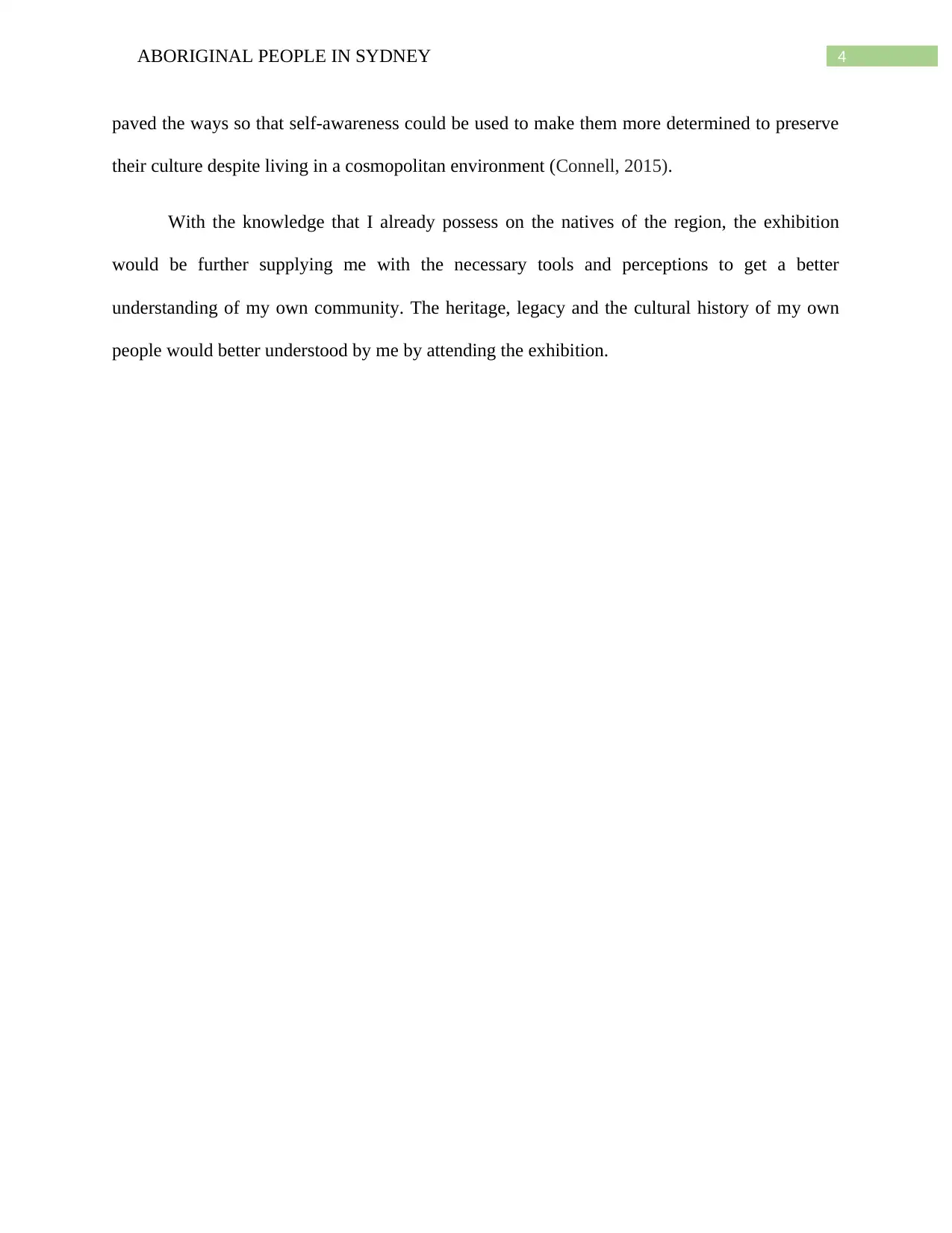
4ABORIGINAL PEOPLE IN SYDNEY
paved the ways so that self-awareness could be used to make them more determined to preserve
their culture despite living in a cosmopolitan environment (Connell, 2015).
With the knowledge that I already possess on the natives of the region, the exhibition
would be further supplying me with the necessary tools and perceptions to get a better
understanding of my own community. The heritage, legacy and the cultural history of my own
people would better understood by me by attending the exhibition.
paved the ways so that self-awareness could be used to make them more determined to preserve
their culture despite living in a cosmopolitan environment (Connell, 2015).
With the knowledge that I already possess on the natives of the region, the exhibition
would be further supplying me with the necessary tools and perceptions to get a better
understanding of my own community. The heritage, legacy and the cultural history of my own
people would better understood by me by attending the exhibition.
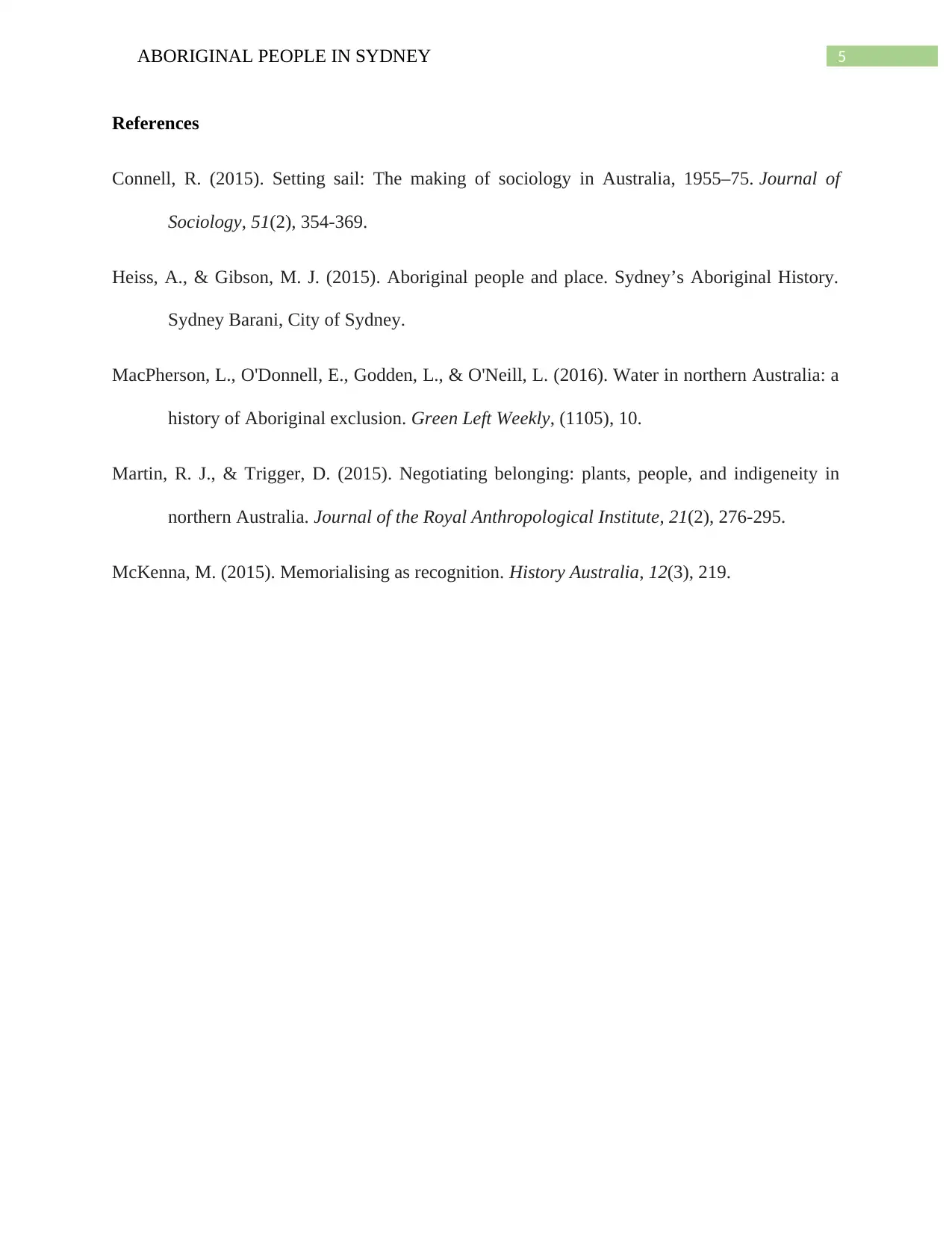
5ABORIGINAL PEOPLE IN SYDNEY
References
Connell, R. (2015). Setting sail: The making of sociology in Australia, 1955–75. Journal of
Sociology, 51(2), 354-369.
Heiss, A., & Gibson, M. J. (2015). Aboriginal people and place. Sydney’s Aboriginal History.
Sydney Barani, City of Sydney.
MacPherson, L., O'Donnell, E., Godden, L., & O'Neill, L. (2016). Water in northern Australia: a
history of Aboriginal exclusion. Green Left Weekly, (1105), 10.
Martin, R. J., & Trigger, D. (2015). Negotiating belonging: plants, people, and indigeneity in
northern Australia. Journal of the Royal Anthropological Institute, 21(2), 276-295.
McKenna, M. (2015). Memorialising as recognition. History Australia, 12(3), 219.
References
Connell, R. (2015). Setting sail: The making of sociology in Australia, 1955–75. Journal of
Sociology, 51(2), 354-369.
Heiss, A., & Gibson, M. J. (2015). Aboriginal people and place. Sydney’s Aboriginal History.
Sydney Barani, City of Sydney.
MacPherson, L., O'Donnell, E., Godden, L., & O'Neill, L. (2016). Water in northern Australia: a
history of Aboriginal exclusion. Green Left Weekly, (1105), 10.
Martin, R. J., & Trigger, D. (2015). Negotiating belonging: plants, people, and indigeneity in
northern Australia. Journal of the Royal Anthropological Institute, 21(2), 276-295.
McKenna, M. (2015). Memorialising as recognition. History Australia, 12(3), 219.
⊘ This is a preview!⊘
Do you want full access?
Subscribe today to unlock all pages.

Trusted by 1+ million students worldwide
1 out of 6
Your All-in-One AI-Powered Toolkit for Academic Success.
+13062052269
info@desklib.com
Available 24*7 on WhatsApp / Email
![[object Object]](/_next/static/media/star-bottom.7253800d.svg)
Unlock your academic potential
Copyright © 2020–2025 A2Z Services. All Rights Reserved. Developed and managed by ZUCOL.